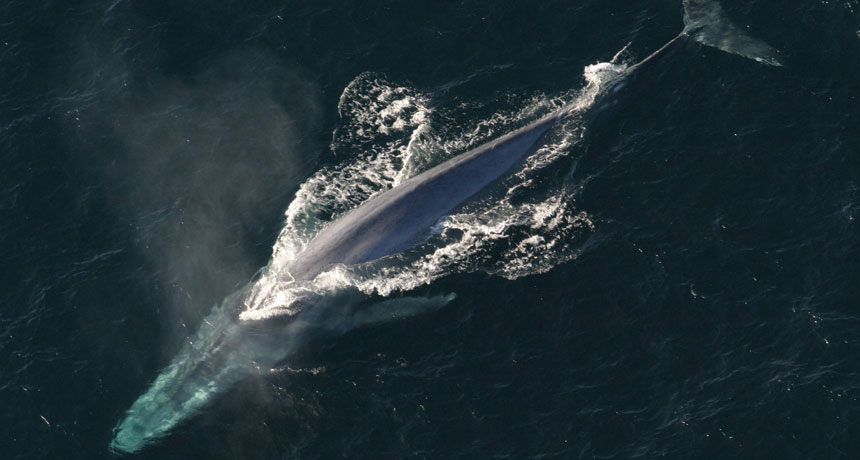Ocean animals have mushroomed in size
Many have bulked up dramatically since ancient eras

This blue whale is the biggest animal ever to live. Today’s sea creatures tend to be larger — many are more than 100 times larger — than their ancient relatives.
NOAA Photo Library/Wikimedia Commons
Ocean animals have been getting bigger over the last half-billion years. Not a little bigger. Not even a lot bigger. They have mushroomed gigantically, scientists now conclude.
Their new finding lends support for something known as “Cope’s rule.” It holds that animals tend to evolve into species that are much larger than their distant ancestors. This hypothesis takes its name from the 19thcentury paleontologist Edward Drinker Cope. While studying fossils, he was the first to notice this trend.
Noel Heim is a paleontologist at Stanford University in Palo Alto, Calif. He also is a coauthor of the new study. His team compared the body size of animals between the Cambrian Period and modern times. This was a span of 542 million years. The animals studied included species from more than 17,000 genera. They ranged from ancient trilobites, plesiosaurs (extinct reptiles with a long neck and flippers) and many less familiar creatures to today’s whales and clams.
Marine animals today are an average of 150 times larger than they were during the Cambrian, Heim’s group reports. The smallest animals alive today — tiny crustaceans called ostracods — are only about one-tenth the size of the Cambrian’s tiniest animals. But today’s largest marine animals — whales — are more than 100,000 times bigger than the biggest in the Cambrian.
“Classes of animals that were already big … tended to persist longer,” Heim says. They also tended to change more than did classes of creatures that started out, on average, far smaller.
The size gains in marine animals are much larger than would be expected by chance, says Jonathan Payne. He’s a coauthor who also works at Stanford.
Findings from the new analysis appear in the February 20 issue of Science.
The scientists don’t know what drives the trend. One possibility is an arms race between predators and prey. The idea here is that larger animals are less likely to become some other critter’s snack. Another possibility has to do with oxygen. Land animals evolved from species that started in the ocean. Some of these land mammals and reptiles eventually returned to the ocean. And they kept the ability to breathe oxygen-rich air. That may have made it easier for them to outgrow animals that had to filter their oxygen out of the water.
Power Words
(For more about Power Words, click here)
Cambrian A period of Earth’s history that lasted from about 541 million to 510 million years ago. It is one of the earliest periods in which fossils can be used to date rocks.
Cope’s rule An observed trend, named for the 19th century paleontologist Edward Drinker Cope. In studying fossils, he found that over time, animals tended to evolve into ever larger forms.
crustaceans Hard-shelled water-dwelling animals including lobsters, crabs and shrimp.
fossil Any preserved remains or traces of ancient life. There are many different types of fossils: The bones and other body parts of dinosaurs are called “body fossils.” Things like footprints are called “trace fossils.” Even specimens of dinosaur poop are fossils. The process of forming fossils is called fossilization.
genus (plural: genera) A group of closely related species. For example, the genus Canis — which is Latin for “dog” — includes all domestic breeds of dog and their closest wild relatives, including wolves, coyotes, jackals and dingoes.
hypothesis A proposed explanation for a phenomenon. In science, a hypothesis is an idea that must be rigorously tested before it is accepted or rejected.
marine Having to do with the ocean world or environment.
ostracod A type of water-dwelling crustacean, sometimes called a seed shrimp, usually smaller than the sesame seeds on a hamburger bun.
paleontology The branch of science concerned with ancient, fossilized animals and plants. A scientist who works in this field is known as a paleontologist.
predator (adjective: predatory) A creature that preys on other animals for most or all of its food.
prey Animal species eaten by others.
species A group of similar organisms capable of producing offspring that can survive and reproduce.
trilobite An extinct group of arthropods that were related to modern-day insects.







